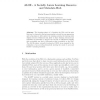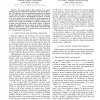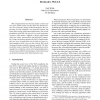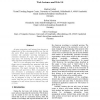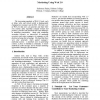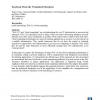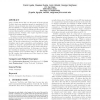ECTEL
2007
Springer
14 years 7 months ago
2007
Springer
The changing nature of e-Learning, the Web, and its users that can be observed in the last years results in a need for new approaches and technologies to fully exploit the existing...
SMC
2007
IEEE
14 years 7 months ago
2007
IEEE
— This paper presents the prototype of an expert peering system for information exchange in the knowledge society. Our system realizes an intelligent, real-time search engine for...
IRI
2007
IEEE
14 years 7 months ago
2007
IEEE
Web 2.0 applications have become popular as drivers of new types of Web content, but they have also introduced a new level of interface design in Web development; they are focusin...
IAT
2007
IEEE
14 years 7 months ago
2007
IEEE
The fast growth and spread of Web 2.0 environments have demonstrated the great willingness of general Web users to contribute and share various type of content and information. Ma...
ISM
2008
IEEE
14 years 7 months ago
2008
IEEE
At many universities, web lectures have become an integral part of the e-learning portfolio over the last few years. While many aspects of the technology involved, like automatic ...
IISWC
2008
IEEE
14 years 7 months ago
2008
IEEE
Web 2.0 represents the evolution of the web from a source of information to a platform. Network advances have permitted users to migrate from desktop applications to so-called Ric...
HICSS
2008
IEEE
14 years 7 months ago
2008
IEEE
The increasing popularity of Web 2.0 tools, such as blogs, wikis, and virtual worlds, is fundamentally changing how consumers use the Web. The basic core of Web 2.0, that users ca...
EDOC
2008
IEEE
14 years 7 months ago
2008
IEEE
: “Web 2.0” and “cloud computing” are revolutionizing the way IT infrastructure is accessed and managed. Web 2.0 technologies such as blogs, wikis and social networking pla...
WIKIS
2009
ACM
14 years 7 months ago
2009
ACM
Information Systems (IS) innovations are often characterized by buzzwords, reflecting organizing visions that structure and express the images and ideas formed by a wide community...
SIGCOMM
2009
ACM
14 years 7 months ago
2009
ACM
Large, socially-driven Web 2.0 sites such as Facebook and Youtube have seen significant growth in popularity [5, 10]. However, strong demand also exists for socially-driven web s...
